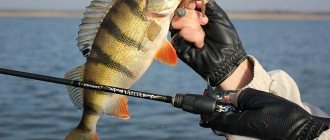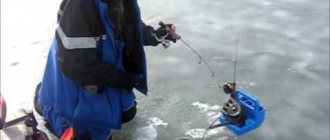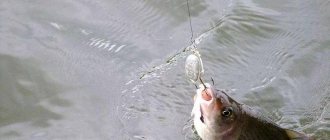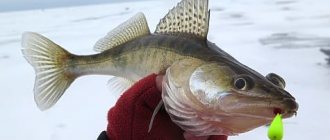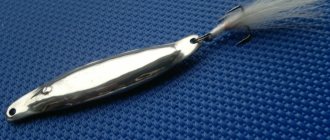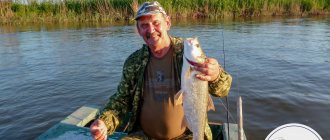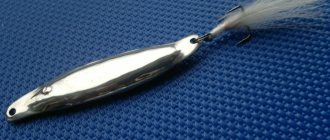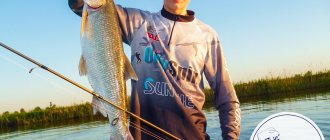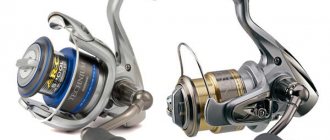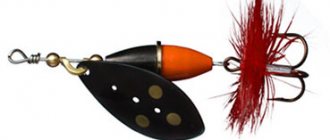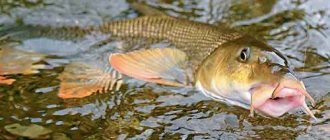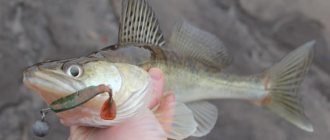Wabiks are unique baits consisting of thin synthetic or other fibers, which are bound and attached to a hook. Wabiks are used not only as independent baits with hooks, but also as an additional element for spinners or wobblers. Read more about this below.
Wabik as an auxiliary bait
Vabik is designed to provoke predators to attack, stimulating their hunting instincts. For example, when a pike or pike perch sees a small predator chasing a fry, they are unlikely to swim past.
It is the wabik that resembles fry in its appearance, and the spinner or wobbler is a small predator that can become a victim for pike.
Even when the pike is passive and does not take any other bait, the sight of a competitor on its territory awakens the hunting instinct and provokes it to attack.
The idea of the auxiliary wabik is to make the appearance of the fry and the small predator that is chasing the fry, that is, the wabik. The main bait (wobbler, spinner, silicone) acts as a small predator. The pike attacks a competitor (the main bait), which is chasing a wabik in its territory.
The wabik should arouse interest on the part of the predator, while the bite itself often goes to the main bait. For this reason, pacifiers without hooks are rarely used.
Fishing technique
The basic technique for catching asp with a streamer is splash hunting. When a predator appears on the surface, attacking the fry, the angler sends the equipment there. After its fall, it begins to quickly retrieve, imitating the behavior of fleeing prey.
Note! It is necessary to calculate the landing point of the bait so that it does not fall on the predator’s head or end up behind his back. The streamer should descend along the path of the fish, then the likelihood of a bite increases significantly.
Wiring of equipment with a streamer is uniform and high-speed. The asp should perceive the bait as an escaping fish. A predator can equally attack both a jig and a bait. The bite is traditionally powerful, sharp and unexpected.
When the asp feeds in the water column, the retrieve is carried out at an average or moderate speed monotonously. The main task of the fisherman is to hold the rig in a given horizon so that it constantly remains in the field of view of the sheresper.
The beard is also suitable for hunting near the bottom, therefore it can be used in spring and autumn, when the fish stays in the lower horizon. The wiring is slow, uniform or stepped with stops. To minimize snags, remove the hook from the jig or tie a lead sinker of the required weight instead.
Asp takes the streamer confidently. If the bait even remotely resembles his natural hunting targets, he is not careful, but attacks easy prey. When hooked, it behaves aggressively and resists powerfully, trying to free itself. It is better to land the fish slowly, bringing it from a distance. When she gets tired, she is carefully brought to the shore and caught in a landing net.
Recommended reading: How to catch carp on a feeder
Vabik with a hook as the main bait
If you want to use a wabik as the main bait, then it is better to equip it with a double or tee. The lead cheburashka acts as a sinker, which is attached to the hook through a winding ring.
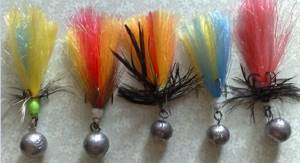
The advantages of wabiks also include excellent fish hooking. Since when using a wabik the hook remains practically bare, the predator immediately hits the sting when attacking and is spotted.
Related article: fishing with poppers
Bombard rig for asp
A bombard is a type of fishing equipment that consists of a plastic tube through which the main fishing line is pulled. Its lower part is somewhat thickened, most often in the form of a drop, like a float . This is all to provide buoyancy and its additional weight. To put it simply, this is a kind of float, which is also called sbirulino .
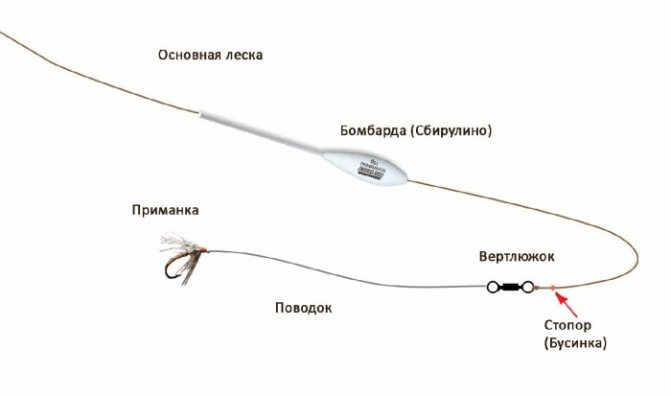
The main functional purpose of this type of equipment is the ability to throw even a light weight bait over long distances.
The most popular method of catching asp is spinning. After all, only thanks to this type of equipment you will be able to catch an excellent predator. Since artificial baits for asp are a pleasant thing, the effectiveness of the spinning rod is obvious.
A video that describes the advantages and features of equipment with a bombard.
Float tackle can also help in catching asp. But in this case, it is worth understanding that this predator is quite careful. Therefore, the tackle must be made for a long release of the bait from the rod. A supply of fishing line is required. Since it is almost impossible for this predator to bite near the fishing spot.
The equipment for the asp consists of the following components:
- main line with a diameter of no more than 0.2 mm;
- bombard itself;
- bead;
- swivel;
- a leash with a diameter of no more than 0.18 and a length of no more than two meters;
- streamer
Such equipment can be made quite quickly. This does not require any special skills, so even a beginner can do this job.
Making a vabik with your own hands
Making wabiki at home is very simple. All you need is a colored thread, which you need to fold several times, tie in the middle, and then cut the ends to make a kind of tassel. Such baits have proven themselves to be excellent, for example, when catching pike perch with a spoon, as additional bait. For more reliable fixation, the tip of the wabik can be coated with glue. If you want to equip the wabik with a hook, then it is advisable to hide the hook inside the wabik.
Larger wabiki work great as independent baits in combination with a Cheburashka sinker.
To increase catchability, wabiki are impregnated with various attractants.
In this case, you need to take into account what threads the wabik is made of, since not all materials are able to retain odors for a long time. Wobbles made of wool and cotton threads are good in this regard, but the downside is their low strength.
The best option when choosing a material for knitting wabik is loose nylon cord, which has high strength and at the same time can retain the odors of attractants for a long time.
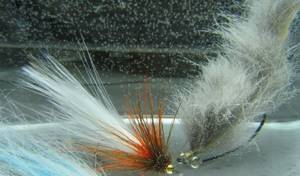
Features of equipment and its installation
The beard for an asp is crocheted directly on a hook with your own hands; the main condition for proper manufacturing is strength. All hairs or feathers must be attached so tightly that they cannot be pulled out. Mostly during manufacturing, white cambrics or a foam float are used. It is possible to make a streamer on spinners and oscillators, but to maintain proper playing, wool is used that is half as long.
Making your own beard:
- We take the material from which we plan to make the streamer and apply it to the hook. The middle of the length of feathers, wool or fur is at the ear.
- We fix the workpiece with a nylon thread, and wrap the excess part of the feathers to the fore-end.
- We tie the base of the material, folded in half, with a thread, while making a kind of head - a thickening of the material, reminiscent of the head of a fry.
- We tie the thread into a knot and cut off all extraneous ends.
- We comb the bait, and apply glue to the homemade head, which must be resistant to moisture.
- We paint the bait white, silver, and black.
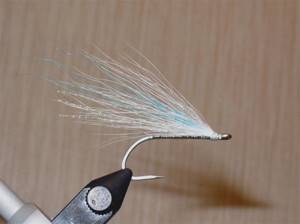
one. How to make tackle by hand:
- We prepare a piece of fishing line about 1 m long.
- We attach a swivel to one side of the leash, and install a clasp on the other.
- On the swivel where the fastener is installed, we attach a “castmaster” or any spinner.
- We attach one beard to a leash 5-7 cm, 25-30 cm from the fastener.
- We attach the second streamer a little higher, on a similar leash.
- The main line is attached to a swivel without a fastener.
Due to the fact that the asp is prone to aggressive bites, it is important to carry out sharp hooks, which monofilament fishing line cannot always cope with. A cord is used to increase sensitivity, but monofilament fishing line can reduce the force of jerks and make the task of the tackle easier.
Read more
How to choose a spinning rod for long-distance casting?
It is important to understand exactly what to catch asp with, since using a streamer of bright colors leads to rare bites. The asp is extremely careful and always looks closely at the prey before attacking. Unfamiliar “living creatures” can scare away fish. Sheresper tends to feed on bleak, so in most reservoirs baits that imitate bleak with a silver or olive color are effective.
Catching sabrefish using wabiki
The sabrefish, which hunt in flocks, bite both on the main baits and on the wabiks themselves, so the latter must also be equipped with hooks. Due to competition, each individual tries to be the first to attack potential prey.
To catch sabrefish, 1-2 reels with hooks will be enough. This fish, as a rule, bites sharply and is easily spotted, after which it behaves extremely actively and often gets very tangled in the line. For this reason, it is not worth overloading the equipment with rams with three or more primers.
If the wabik will be used as the main and independent bait, you need to carefully choose its color. So, sabrefish bite best on black-and-white and silver wabiki, which most likely remind it of fry.
To get rid of bites from small sabrefish, it is recommended to use voluminous wabs attached to large double or triple hooks. There will be fewer bites, but the saber fish will become larger.
Installation of gear
If you fish with a streamer as an independent bait, then it is better to use ultralight gear. Its weight is only 1–3 grams. This method of fishing is relevant on small rivers, when a predator can be caught at close range.
Tip: Fishing with a streamer is effective in the summer under branches overhanging the water, along steep banks, at local points.
Much more often, asps are caught with a beard, using the same long-range gear as for fishing with heavy spoons - a tall spinning rod, a powerful reel, and a sliding line. It is important to assemble the equipment correctly. The basic installation option is as follows:
- A leash up to 1.5 meters long is attached to the main line.
- At its end we attach a swivel with a fastener for a jig or other heavy bait.
- 30 cm from the end of the leash we make a loop 1–2 cm long using a figure eight knot.
- We knit the second loop in the same way, again retreating 30 cm. If desired, make a third after another 30 cm.
- We make short bends 10–15 cm long, at the ends of which we tie wabiks.
- We mount them to the leash using the “loop-to-loop” method.
Recommended reading: Fishing for cicada lures
That's it, a simple assembled beard. Its advantage is the absence of unnecessary elements and minimal cumbersomeness. During casting and movement in the water, the equipment does not get tangled, remaining attractive to the asp.
Some anglers attach double and triple swivels to the main leader to minimize line twist. This saves the equipment from possible tangling, but reduces its strength. Increases the requirements for each of its elements and the quality of knitting knots.
Wabiki for chub
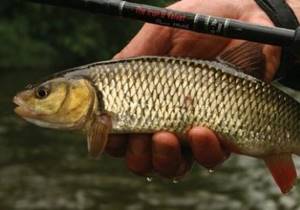
To catch this predator, it will be enough to use one high-quality bait. As for the color of the bait, it is best to use a bait with combinations of black, grey, yellow and red colors for chub.
For example, it could be a yellow bait with black tips or a white bait interspersed with red and black colors.
Spinning baits: from wabik to streamer
Vabik is a rather rare bait. I think I won’t be mistaken in saying that most spinning anglers, like almost all fly fishing enthusiasts, do not use a wabik. This is because the spinning rod, as a fishing bait, does not inspire much confidence, and fly fishermen consider its use beneath their dignity (it’s too simple). Yes, simple, but more than enough to get the fish to bite.
And if you improve it a little, then a simple wabik turns into a full-fledged streamer, the creation and use of which is creative, exciting and new for many spinners. To take the first step, you need to understand, overcoming some stereotypes, why fish bite on a wabik, which does not imitate any object of its food.
Among the multi-colored and sparkling lures of fishing store windows, it is difficult, and sometimes even impossible, to notice a modest wabik. Once, when asked: “Do you have wabiki?”, I heard: “What is this?” Really, what is this vabik? A wabik (historically) is a device (such as a pipe or whistle of various designs) for luring game. The device is thus acoustic, which we better know as a decoy. When and how the name of the hunter’s whistle began to designate the simplest fishing bait (such as a brush made of threads, wool, or feathers), I did not understand. But I know and use many variations on the wabik theme, which are no less effective in catching a wide variety of fish than twisters, vibrating tails, wobblers and other representatives of the elite of the modern fishing industry.
Lures made on the basis of wabik suit me both as a fly fisherman, where I am more of an esthete, and as a spinning angler, where I am an absolute pragmatist. This is because, on the one hand, they are good-looking, and on the other hand, they are so cheap and technologically advanced that you don’t mind losing them on hooks during bottom fishing using jig or lead rigs. And that's not the main thing. The main thing is that the extreme variety of these baits and their infrequent use helps to overcome the effects of indirect learning inherent in fish. It manifests itself in conditions of fishing pressure in that the fish refuses to bite on “tired” (initially very effective) baits, but readily responds to something new, which, from its point of view, does not threaten it with being taken out of the water.
A wabik, which is similar in appearance to one of the most ancient fishing lures, a bucktail, can be made very, very simply. After winding 15-20 turns of thread (nylon, nylon, viscose) onto a reel, we cut the resulting ring into bundles about 2 times the length of the hook shank of the required size. Next, we pull the threads out of the bundle: a couple of millimeters, grabbing two or three more each time. As a result, we form a narrowing towards the end, approximately equal in length to the shank of the hook (photo 1), while the other end takes on the same shape. Having folded the bundle a third of the way, we wind it to the shank of the hook near the eye. Finally, we make a couple of simple knots, cut the thread and treat the winding with nail polish. Photo 2 shows several wabiks made in this way from a bundle of threads, and photo 3 shows them from natural (wool) and synthetic (acrylic) fibers.
The latter are even easier to do: you need to pull out a bundle of the required thickness from the mass of fiber and wind it to the shank of the hook, leaving a “tail” of the required length, cut off the excess and complete the winding with a knot. The shank of the hook can be left “bare”, as in photos 2 and 3 (this is a wabik in its pure form), or it can be pre-wound with a thread contrasting in color to the main beam, or with a shiny material, steel or copper wire, or even coated with colored varnish . To create multicolor, you can combine threads and fibers of different colors. This will already be a full-fledged streamer, although the boundary between them (vabik and streamer) is quite arbitrary. I specifically do not show classic bucktails here, since deer tail can only be purchased in departments that sell fly fishing materials and accessories. The baits discussed in this article are knitted from materials purchased at a sewing supply store, where their cost is ten times lower.
Wabiks work great when attached with a carabiner to the ear of a Cheburashka as a jig bait, or when tied to the line above the sinker with a Palomar knot in a Drop shot rig. Lead rigs are also not contraindicated for them. Nevertheless, the soul (and the fish too) wants variety. But there are problems: theoretical and practical. The theoretical one sounds like a question: what should we do and why? To answer, you first need to determine what has been done. And a lot has been done if we consider the examples of wabiko presented above from the point of view of proven irritants that cause an attack on the bait by fish. Therefore, let me touch a little on the understanding of wabik as bait. Wabiki (and many streamers) do not imitate specific living creatures. They represent to the fish a certain sum of their properties, and these properties often belong to different creatures. Such baits are called fantasy, in contrast to realistic models (simulators), which with varying degrees of reliability depict real food objects, most often different stages of the underwater and surface life of specific insects (mayflies, caddis flies, beetles), but wabik is not one of those. Vabik, like many spinning baits, does not imitate any specific “usual fish food items”. In quotes, because often (much more often than necessary) it is the imitation of “habitual fish food” that we are offered to use as a spinning bait. And we, due to stereotypes, most often perceive a spinning bait as an imitator. At the same time, without much thought, we successfully catch the same pike perch using imitation of animals that he has never seen in his life, for example, squid and octopuses (“tubes” and “octopuses”).
In this case, there is obviously no need to talk about any predilection for squid or octopus in the diet of pike perch. Pike perch also bite regularly on a twister (and this is one of the most popular spinning baits). If we take a closer look at a twister, for example, a light green color, it will become clear that it does not imitate any of the “usual fish food items.” Its “ribbed” body may look like a worm, but the manner of its tail “working”, movement and color are not. Worms don’t swim like that, aren’t painted like that, and don’t produce water vibrations like that. Maybe he's imitating a fish? Hesitation - yes, it seems. And the rest (the color or shape of the tail, especially when moving slowly - in the form of a question mark) does not resemble a fish in any way. It turns out that there are no food objects in the aquatic environment that a salad twister could imitate.
But the fish are biting. This is because the twister is a fantasy bait. Without any specifics, the twister presents the fish with a combination of several properties of edible objects: movement, shape, size, vibrations and color contrast with the background. The color may even be one that is not found among local representatives of the fauna, the main thing is that it contrasts with the environment, because contrast is the usual landmark in the search for food. Most often (when the fish has no special preferences, and this is a separate topic), it does not matter what color this contrast is created, the main thing is that it makes the bait more noticeable. Like the twister, many other spinning baits are also not imitators. What living creature can imitate a spinner? None, because no living creature of such edible size would display itself so fearlessly with its movement, sparkles and vibrations. The purpose of this bait is to provoke a bite with a combination of properties: the ability to move, sparkle and spread vibrations. And we somehow got used to thinking that it is a fish (or a bug - if it has a forked black petal).
Among the wobblers that imitate the shape of a fish, there are very few “natural” colors; there are more and more diverse multi-colored “acid” ones. This is also because fish are often not interested in the specifics of color in the sense of connection to a familiar food item. But such wobblers as jerks, cranks, and balls in their pure form (for example, Jakson Akkan Bem 20F - a ball with eyes, a blade and a hook) do not imitate the shape. We can continue by considering what exactly these or other spinning baits represent - specific food objects or fantasies about their properties, but what was stated above allows us to think about it before stereotypically considering baits only as imitators. Let's return to the vabik, or more precisely, to its properties. In addition to the main stimulus - movement in a certain way, making the bait more noticeable against the background of the surrounding space, and representing to the fish the fundamental property of living objects - the ability to actively move, there are also some others, by which the fish determines whether they belong to the category of edible. Firstly, it is spindle-shaped. A very characteristic shape of living creatures living in the water column, although for fish the priority is not the shape of the bait, but its size. For example, depending on the prevailing food or environment, fish can be very picky about size.
If a predator “sits on the fry” or lives in conditions of severe food competition (when, for example, a pike needs to immediately swallow the victim, and there is no time to turn more conveniently - they will take it away), the use of small bait is more justified than large one. And in the fall and spring (before new fry appear) - on the contrary, large bait is, as a rule, more effective. Secondly, the changing volume of the wabik (“breathing”), induced by the uneven speed of the drive, may resemble the movements of the gill covers of a fish or the alternating contraction (“swelling”) and stretching of the body of moving worms and leeches. And the installation of a wabik paired with a flat sinker (for example, a “tablet”) makes it move like a “snake”, depicting the nature of the movement of the fish. Vabik, thus, represents to the fish the mobility of the form of living beings: the ability to change volume, bend, wriggle, etc. Thirdly: the contrast of the color of the object with the color of the background (the thickness of the water, the bottom, or the “sky”), which in different conditions most noticeable in appropriately colored baits. For example, at a relatively shallow depth, red and orange colors can contrast well with the greenish background of the water column, yellow and light green colors can contrast well with the color of the bottom and “walls” of the edges, white ones are good in cloudy weather, and black baits are best visible against the background of the “sky” in twilight. At great depths, purely red and purple baits can completely lose their color, because the red (and infrared), as well as the violet (and ultraviolet) ranges of the visible spectrum are delayed by the first meters of water. Most often, visibility works, not color to match the usual food item.
Visibility can be emphasized by contrasting the bait itself, making it two-color or even multi-color. Thus, even the simplest wabik can demonstrate to fish at least four properties of living objects (shape, size, “breathing,” color contrast), which, combined with animation that simulates the ability to actively move, make the wabik “desired prey” for a predator. By adding, selecting or emphasizing other properties, you can improve the wabik, creating models (already models of streamers) both universal and for specific fishing conditions. On this path, a second problem arises (practical). It consists in the need to purchase some equipment for tying flies, because you cannot make a “masterpiece” with your hands. The knitting minimum (photo 4), in my opinion, includes a vise for the hook, a bobbin holder (thread driver), a thread threader and a knotter. I won’t talk about sharp scissors; every fisherman has them. The finishing knots can be quite simply knitted with two fingers, and the thread can be blown into the bobbin holder (literally), but it is more convenient to do this with special tools. By the way, the thread threader can be bent from the steel vein of a “vole” or the first string of a guitar. Now we can continue.
The next important property is the glare of reflected light, including polarized light, which unmasks even a living creature colored to match the color of the bottom or water column. These highlights are formed due to a layer of mucus that “polishes” the surface of the body of aquatic animals, are noticeable at a great distance and are one of the important landmarks of a hunting predator. The designs of many streamers use lurex or tinsel, which are round, flat, twisted, broken and woven (crystal flash, tinsel, etc.) and serve the purpose of creating glare (photo 5). Lurex can be added to a bundle of threads (in photo 5 - the first wabik from above) or you can wrap it in different ways around the shank of the hook (in the photo - the two lower ones), you can also form the bundle itself from a metallized thread, in which the foil is presented in the form of one strand around the base ( in the photo - the second vabik from the top). If the streamer is not made tightly, it demonstrates translucency, which for fish is a familiar property of living creatures that provide it with food, both in childhood and in adulthood (plankton, mosquito larvae, especially coretra, fry and adult small fish).
A wabik made from synthetic or woolen fibers, due to their “looseness,” is itself translucent, and in order to make a bunch of threads transparent, they must be made to stick out at the place where they are tied to the hook. Structurally, this can be done in several ways. The easiest way is to wind a thickening at the place where the bundle of threads is attached, thanks to which the wabik acquires volume and pronounced translucency (photo 6, two “fluffy” wabiks - photo 7). Thickening can be created not only by winding the mounting thread, but also by other materials that create the body of the bait. Photo 8 shows a wabik made from a bundle of thin lurex (metalized thread), the body of which is formed by wrapping the fore-end with bulky yarn, like chenille traditionally used in fly fishing, only thicker (corduroy) and in which I risked bringing the transparency of the body, as they say, to the point of absurdity. And I was right. The streamer works great in clean water in winter (photo 9). The body formed by a wound strip of foam, which can be tinted with a waterproof marker or wrapped with lurex, looks good (photo 10). The last option deserves special attention. The foam gives the streamer a certain amount of buoyancy, which is useful when using lead rigs on a rocky bottom, and when jigging, it does not allow the hook with the wab to lie on the bottom when it touches the load, which in both cases significantly reduces the number of hooks. And the lengthening of the pause, especially noticeable with relatively small jig weights, also matters. Another visible property that reflects the fundamental principles of the structure of living organisms is body segmentation. Worms, insects, and crustaceans are all made up of segments, including the body and limbs (in arthropods).
The fry and small fish are also segmented when viewed through the light (both the ribs and the processes of the vertebrae are visible). The easiest way to depict segmentation (“external”) is to walk transversely across the finished vabik with a waterproof marker (photo 11). “Internal” segmentation is easily depicted by wrapping the body with shiny wire, lurex (as in photos 5 and 10), and tinsel. Or you can use a twisted bundle of threads, which is wound with a “corkscrew” around the shank of the hook. In the case of a translucent body, such “internal” segmentation is clearly visible (photo 12, taken from the side of the hook tip). Photo 12 demonstrates another important property, which no longer relates to the food object, but to the way the fish identifies it. Studies of the fish’s perception of the surrounding space have led to the conclusion that it focuses its attention on the boundary of a potentially edible object with the background, that is, we can say that it perceives objects in a contour manner.
What can be done to emphasize the contour, “helping” the fish habitually perceive the bait? Structurally - tie the streamer “empty”, that is, so that the threads or fibers form some kind of shell. All of the above methods of creating translucency of a bundle of threads, but in combination with a bundle of thin fibers (wool or acrylic) and when viewed through the light, in addition to translucency, create a noticeable outline of the bait. The presented designs do not contain elements that create vibrations when retrieving the bait, although adding them is quite simple. To do this, before forming the head of the streamer, a bent piece of thin rubber is wound perpendicular to the shank of the hook in a figure eight, the protruding ends of which are cut off, leaving 0.5–2 cm (photo 13), depending on the size of the bait itself and fishing conditions (standing water - longer, strong current - shorter). For lovers of attractants, I can note that the materials used for streamers perfectly retain odorous substances. And smell and taste are undeniable food irritants that attract fish and, if they bite, force them to hold the bait in their mouth longer.
Thus, streamers made using a bundle of threads or fibers (that is, based on wabik) can present fish with a variety of combinations of almost all known food stimuli inherent in the food items of predatory fish. These are, in addition to movement, size, shape, “breathing,” color contrast with the background, glare of reflected light, translucency and contour, segmentation, vibrations, as well as smell and taste. More than enough if we consider the bite from the point of view of the feeding behavior of the fish. And from the point of view of a spinner, this is not only cheap and technologically advanced, but also the longest-range product, which can sometimes be decisive for fishing from the shore. And one more thing: when there is a ban, a storm or frost, you can sit at home not just watching TV, but spend time with benefit and interest: replenish the “ammunition” that has become thin on the hooks or experiment in search of new models of this simple but very effective bait.
Wabiki for asp
The asp is a very cautious fish that does not allow the fisherman to get too close.
It follows from this that the bait for catching asp must be long-range, providing a cast of 40 meters or more.
In this case, you can use wabiki with special drop-shaped weights, see photo below. To catch active asp, you can use a wabik as the main bait.
But most often, to catch asp, a wabik is used as an additional bait, and, for example, a long-range spinner - castmaster - is used as the main one.
Features of catching asp with a beard (streamer)
Content
Catching asp on a spinning rod using a streamer is distinguished by its catchability, since the nozzle imitates mice, fry and toads well. Artificial materials, feathers and fur are often used to make a beard. The listed components hold well in water and allow high-quality imitation of prey.
Each type has its own characteristics:
- artificial. Particularly effective when hunting perch and pike perch. They keep their shape better than others, dry quickly, but lose their play when fishing in an intense current;
- feather Experienced fishermen always use feather options for asp, as they have an even and smooth game even during fast retrieves or fishing in the current. To improve the equipment, add a head made of deer fur; such equipment holds even better in fast currents;
- fur. They are universal models, suitable for any water surface. They do not lose their play during strong currents and remain attractive in still waters. Most often used for catching pike.

There are other features of the asp beard tackle:
- Asp are caught using a streamer during periods of low activity, especially in the heat. With the correct presentation, the fish’s hunting instincts awaken, then it attacks the bait;
- if you successfully throw the bait directly into a school of sheresper, there is a high probability of catching 2 individuals in one landing;
- the choice of this bait is justified in areas with an abundance of underwater vegetation and snags. When fishing with a spinning rod or fly fishing, the barb has less chance of getting tangled under water due to the compactness of the bait;
- It is good to fish with a streamer at all depths. After an accurate cast, you can catch the asp in deep holes or perform surface retrieves;
- The manufacturing technology uses lightweight materials that do not allow long casts. A sinker is used to deliver bait over long distances;
- the bait is suitable for fishing on any current using different fishing styles, since it does not sail and is resistant to entering a corkscrew;
- The beard rig for asp fishing can be used in all seasons and shows good results all year round;
- It is important to make accurate casts right away; fur models quickly get wet and lose their catchability. Synthetic and feather options are better able to withstand getting wet;
- It is better to attach attractive devices to the tail of the streamer, but not bright ones. Beards that imitate the appearance of the inhabitants of a particular body of water perform better. The colors may be different, but the following products show themselves well on asps: gray, white and black products. Some bright colors help catch asp, but solid varieties are still better;
- The asp attacks prey that is 4-5 times smaller than itself. Taking this feature into account, the nozzle is prepared from 5 to 8 cm in length.
Read more
Pros and cons of Aiko spinning rods
